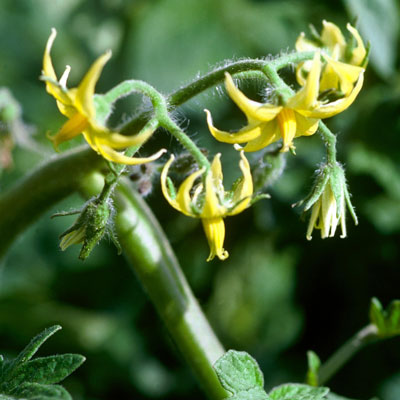Question of the Week: March 21, 2019
“Why don’t my tomatoes set fruit?”
Tomatoes are Texans’ favorite vegetable, grown in a large majority of our home gardens. Yet they’re also a source of great frustration. Here are a few tips to success, as well as a few possible reasons for failure. You might want to scan through them.

Tasty, ripe tomatoes will soon be ready for harvest.
To ensure the best possible chances…
• Plant tomatoes in full sun.
• Give them well-prepared soil to which you’ve added several inches of different types of organic matter.
• Plant one to two weeks after the average date of the last killing freeze for your area.
• Buy stocky, healthy transplants, preferably with reddish stems (means they’re toughened up to outdoor conditions).
• Space the plants 48-52 inches apart in rows.

Vigorous tomato plants are growing in collapsible wire cages that can be saved and reused year after year. This keeps the fruit up off the ground.
• Grow in 17- or 18-inch wire cylinders 48-52 inches tall to keep fruit off ground.
• Watch closely for insect and disease pests, and treat at first signs with labeled control.
• Apply nitrogen fertilizer and water to keep the plants growing vigorously. Your soils almost assuredly already have ample or excessive amounts of phosphorus, so no more will be needed.
Variety selection is critical!
• Large-fruiting varieties do not set fruit well in Texas’ summer conditions, so limit their numbers to just one or a few. Big Boy, Beefsteak and similar giants were bred for the Midwest with its cooler night temperatures. They will not set fruit in the heat.
• Best types for us are the small-fruiting and mid-sized varieties. The list would include Red Cherry, Yellow Pear, Sweet 100, Porter, Roma, Celebrity, Super Fantastic, Early Girl and Tycoon.

A trick that may help your tomatoes set fruit…
Tomato flower clusters are pollinated by mechanical vibration, not by insects. Usually that’s provided by wind, but often we plant them in backyards that are sealed off by privacy shrubs and fences. It may help to thump the flower clusters every couple of days to vibrate the pollen loose within the flowers. Give it a try and see if you don’t get more fruit for your efforts.
